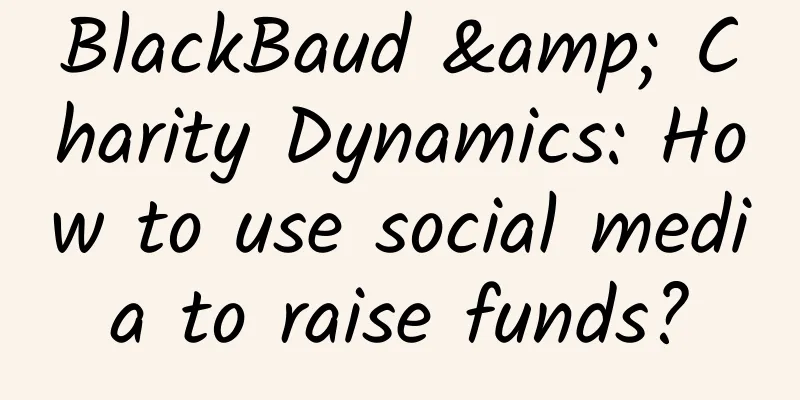BlackBaud & Charity Dynamics: How to use social media to raise funds?

|
In recent decades, fundraising through contests (“a-thons”) has become an important part of nonprofit fundraising. This method is successful because it can be so targeted or personalized that new donors are often influenced by their friends or siblings to give generously to the nonprofit they support. And this form of fundraising is also perfect for using social media tools, which are inherently very targeted and personalized. So we were not surprised by the research report jointly released by BlackBaud and Charity Dynamics. The conclusion of the report is clear: if you, as a nonprofit, are not providing social media tools for fundraising to fundraisers, you are missing out. So how can fundraisers use social media tools more successfully? Here are a few key points revealed in the report:
Download the white paper: Raising more money for independent fundraising campaigns through social media The following is a summary of the report: 1. Introduction : Social Networking is Revolutionizing Independent Fundraising: In 1999, the emergence of personal fundraising web pages, coupled with personalized fundraising emails, revolutionized independent fundraising. Since then, the amount raised online has grown by an average of 50% per year, and today, online donations account for 30% of most major U.S. fundraising activities. In particular, the recent explosion of online social media—most notably Facebook, Twitter, and YouTube—is destined to revolutionize the field of online fundraising. Figure 1: Fundraising Amounts Received Online in the United States, 2000-2008 2. Use FaceBook and Twitter as fundraising tools: (2) Allowing independent fundraisers to send messages to Twitter (tweet) and update Facebook status directly from their personal fundraising console; (3) All Twitter messages and Facebook status updates contain links back to the personal fundraising homepage; (4) Ability to generate reports on Twitter and Facebook data and usage, and count the amount of money raised. 3. Analyze the success of Twitter in fundraising applications <br /> Analysis data shows that independent fundraisers who use Twitter set fundraising goals that are three times higher than those who do not use Twitter. Twitter users also perform well, with their actual average online fundraising amount being 10 times that of fundraisers who do not use Twitter. Figure 2: Comparison of fundraising goals and actual amounts raised by fundraisers who used Twitter and those who did not in 2008-2009 4. Analyze the success of FaceBook in fundraising applications <br /> Unlike Twitter, where messages are limited to 140 characters, FaceBook provides more options for designing fundraising applications. The various advanced applications supported by FaceBook are invaluable aids for both rapidly growing nonprofit organizations and independent fundraising campaigns. Generally, a full-featured FaceBook fundraising tool should include the following features: The data shows that the most successful fundraisers tend to use a combination of several social networking tools. In general, they raise 40% more money than fundraisers who do not use online social networks. 5. Analysis of YouTube Fundraising Applications <br /> If “a picture is worth a thousand words”, then the fundraising potential of a video can be imagined, and its fundraising effect may be very huge. An online fundraising tool that integrates YouTube videos should at least do the following: 6. Comparison of fundraising through social networks and fundraising through email <br /> According to statistics, each independent fundraiser sends an average of 28 contacts to solicit donations, and an average of 25 people will eventually make donations and become donors. The average fundraiser has 130 friends on Facebook, and the average number of friends on Twitter is 70. 7. Analysis of the composition of independent fundraisers and donors <br /> Research shows that social networking sites have created a large number of opportunities for independent fundraisers to raise funds. Currently, more than half of fundraising activities are carried out through social networking media. On the other hand, the number of fundraisers who use multiple social media at the same time is also increasing. 8. Ensure third-party fundraisers adopt social network guidelines Reprinted from: //article.yeeyan.org/view/ecauses/113040 |
>>: The harm and prevention of straightening of cervical curvature
Recommend
Women have bad tempers and get angry easily
Nowadays, the pace of life is getting faster and ...
What kind of bird lays quail eggs? How many grams does a quail egg weigh?
Quail eggs are a kind of delicacy, known as the &...
Inability to urinate after childbirth
Having a baby is a big deal, and a woman's bo...
Why do you always think you are ugly? Maybe you have "Imagined Ugliness Syndrome"
Audit expert: Li Xianhong National Level 2 Psycho...
Can pregnant women have their teeth extracted and filled?
As we all know, pregnancy is the most difficult p...
What kind of inflammation is it that causes the perineum to swell and hurt sometimes
If a woman experiences swelling and pain in the p...
ECMO, the last line of defense for life
As of now, the number of COVID-19 infections worl...
International Stomach Protection Day | Receive the stomach care guide to keep your stomach healthy
International Stomach Protection Day is also know...
The fetal sac was expelled a few hours after the medical abortion
How long does it take for the gestational sac to ...
Will eating glutinous rice balls cause constipation? How to eat glutinous rice balls more healthily?
Tangyuan is a kind of food mainly made of glutino...
Pregnant women dream of bayberry trees
What does it mean when a pregnant woman dreams of...
What's wrong with a lump on the vulva?
A lump on the vulva is a common symptom for many ...
What kind of woman is the most beautiful? It's enough to satisfy these
There are many women with beautiful appearance in...
What is the solution for delayed menstruation?
Many women have physical problems, which seriousl...
This food is inexpensive and of high quality. It not only fills you up and prevents constipation, it’s also good for your eyes!
Today's workers are not only physically tired...









